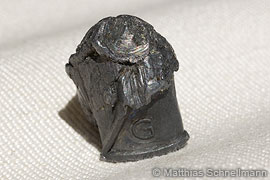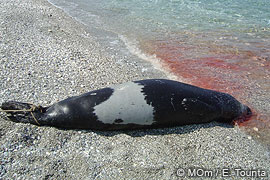An epidemic of killings
William M. Johnson
It is hard to imagine anyone not being moved by the tragic tale of ‘Markos’ – the young Mediterranean monk seal who was brought into intensive care, struggling for life, but horribly mutilated by the bullet that shattered his jaw and nasal cavity.
Possibly it was a blessing in disguise that, despite the valiant attempts to save him, he ultimately succumbed to his injuries, for it seemed doubtful that he would ever swim, dive, or grace the Aegean again.
The killing of monk seals in Greece, according to national NGO MOm, is reaching “epidemic proportions".
The organisation has recorded 15 deaths since January, 5 of which yielded conclusive evidence of deliberate killing. Another killing by gunfire was reported in Turkey on the Bodrum peninsula on 21 April. With other killings just as likely to go undetected along remote coastlines, the final death toll is anybody’s guess.
 |
|
 |
|
Bullet …
|
|
… and victim.
|
Some 13,600 kilometres away on the Main Hawaiian Islands, authorities, NGOs and volunteers face a similar crisis, contending with an upsurge in hostility towards the Hawaiian monk seal that has left three animals shot dead since 2009. What has the collective response been? On the legislative front, the Hawaiian State Senate unanimously passed a bill making the killing or harassing of a monk seal punishable by up to one year in jail and a $50,000 fine [Tougher penalties for seal killers, this issue]. On the investigations front, the NOAA Office of Law Enforcement is on the trail of the killers. One was tried, convicted, and sent to jail in September last year [Killings on Kauai, TMG 12(2): November 2009]. In another case, NOAA announced a $5000 reward for information leading to the arrest of the perpetrator, a bounty that was raised to $30,000 through NGO action and private donations. In tandem with enforcement, NOAA are mounting a well-funded public outreach and education campaign, aimed at bringing the monk seal, Hawaii’s official state animal now, into local hearts and minds.
So what, may you ask, is being done to reduce the shooting and dynamiting of the Mediterranean monk seal – supposedly Europe’s most endangered marine mammal? The answer, unfortunately, is very little:
- There are no ongoing criminal investigations into the recent shooting and dynamiting incidents that have left at least 5 monk seals dead since January 2010.
- No reward for further information is being offered, either by the authorities or international organisations.
Some additional facts:
- Under Greek legislation (Presidential Decree 67/81/29‐11‐1980) it is illegal to kill, capture or harass endangered species, including the monk seal. However, with no penalties established, the law is regarded as largely ineffectual. As far as we are aware, no one has ever been tried or convicted of killing a monk seal in Greece.
- Some fishermen are known to carry firearms in their boats, though the practice is also illegal.
- Facing dwindling fish stocks, and fierce competition from commercially intensive fisheries, coastal fishermen have long considered the monk seal a pest that ‘steals’ their catch and damages their nets.
- MOm estimates that some 54% of monk seal fatalities can directly or indirectly be attributed to the fisheries sector, with 35% of dead seals examined having been deliberately killed, and 18% having drowned in nets.
- Last year, MOm concluded a 3-year EU-funded research programme in association with the Fisheries Research Institute aimed at bringing about practical solutions to reducing monk seal-fisheries interactions. Although their recommendations – which included improved fisheries management to increase fish stocks and yields – were submitted to the relevant ministries, it reports that "unfortunately, up to date, no significant progress has been made."
2010, we are told, is the UN’s International Year of Biodiversity and yet for all the talk about meeting future biodiversity targets, admissions of past failure, remedying mistakes, and 1000-page reports, ironically the most eloquent testimony belongs to a young seal already shot dead – the future of a dying species.
|
We are presenting several stories this issue devoted to the Mediterranean monk seals who have been killed since January:
If you would like to air your views on these stories, please let us know:
.
|
Further information
MOm. 2009. Action Plan for the mitigation of the negative effects of monk seal ‐ fisheries interactions in Greece, Summary Report. MOm, WWF Greece, Fisheries Research Institute, 2009: 1-11. [PDF  2.9MB] 2.9MB]
MOm. 2009. Έξαρση των θανάτων μεσογειακών φωκών, 20 April 2010.
Notarbartolo di Sciara, G., S. Adamantopoulou, E. Androukaki, P. Dendrinos, A.A. Karamanlidis, V. Paravas and S. Kotomatas. 2009. National strategy and action plan for the conservation of the Mediterranean monk seal in Greece, 2009 ‐ 2015. Report on evaluating the past and structuring the future. Publication prepared as part of the LIFE‐Nature Project: MOFI: Monk Seal and Fisheries: Mitigating the conflict in Greek Seas. Hellenic Society for the Study and Protection of the Mediterranean monk seal (MOm), Athens. 1-70. [PDF  3.4MB] 3.4MB]
SAD-AFAG. 2010. Unsolved seal murder in Bodrum Yalıkavak, 27 April 2010.
|






